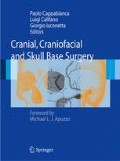Abstract
The supraorbital eyebrow craniotomy is an anterolateral approach that allows the surgeon to address diverse pathology of the anterior cranial fossa, parasellar region, proximal sylvian fissure, ipsilateral circle of Willis, basal frontal lobe, and ventral brainstem. When supplemented with intracranial endoscopy, lesions of the lateral cavernous sinus, pituitary fossa, contralateral circle of Willis, and ipsilateral retroorbital space may be addressed. The goals of the approach are to treat neurosurgical lesions using a less-invasive technique, limit brain retraction and tissue trauma by exploiting anatomic corridors, offer comparable safety and efficacy relative to standard approaches, and yield a good cosmetic result.
Access this chapter
Tax calculation will be finalised at checkout
Purchases are for personal use only
Preview
Unable to display preview. Download preview PDF.
References
Frazier CH (1913) I. An approach to the hypophysis through the anterior cranial fossa. Ann Surg 57:145–150
Krause F (1908) Chirurgie des Gehirns und ruckenmarks nach eigenen erfahrungen. Urban & Schwartzenberg, Berlin
Al-Mefty O (1987) Supraorbital-pterional approach to skull base lesions. Neurosurgery 21:474–477
Fujitsu K, Kuwabara T (1985) Zygomatic approach for lesions in the interpeduncular cistern. J Neurosurg 62:340–343
Maroon JC, Kennerdell JS (1984) Surgical approaches to the orbit: indications and techniques. J Neurosurg 60:1226–1235
Zabramski JM, Kiris T, Sankhla SK et al (1998) Orbitozygomatic craniotomy: Technical note. J Neurosurg 89:336–341
Yasargil MG, Fox JL, Ray MW (1975) The operative approach to aneurysms of the anterior communicating artery. In: Krayenbuhl H (ed) Advances and technical standards in neurosurgery. Springer, Vienna, pp 113–170
Reisch R, Perneczky A, Filippi R (2003) Surgical technique of the supraorbital key-hole craniotomy. Surg Neurol 59:223–227
Czirjak S, Nyary I, Futo J, Szeifert GT (2002) Bilateral supraorbital keyhole approach for multiple aneurysms via superciliary skin incisions. Surg Neurol 57:314–323
Jho HD (1997) Orbital roof craniotomy via an eyebrow incision: a simplified anterior skull base approach. Minim Invasive Neurosurg 40:91–97
Perneczky A, Muller-Forell W, van Lindert E, Fries G (1999) Keyhole concept in neurosurgery. Thieme, Stuttgart
Reisch R, Perneczky A (2005) Ten-year experience with the supraorbital subfrontal approach through an eyebrow skin incision. Neurosurgery 57 (4 Suppl):242–255
Lan Q, Gong Z, Kang D et al (2006) Microsurgical experience with keyhole operations on intracranial aneurysms. Surg Neurol 66 (Suppl 1):S2–S9
Mitchell P, Vindlacheruvu RR, Mahmood K et al (2005) Supraorbital eyebrow minicraniotomy for anterior circulation aneurysms. Surg Neurol 63:47–51
van Lindert E, Perneczky A, Fries G, Pierangeli E (1998) The supraorbital approach to supratentorial aneurysms: concept and technique. Surg Neurol 49:481–489
Paladino J, Pirker N, Stimac D, Stern-Padovan R (1998) Eyebrow approach in vascular neurosurgery. Minim Invasive Neurosurg 41:200–203
Brydon HL, Akil H, Ushewokunze S et al (2008) Supraorbital microcraniotomy for acute aneurysmal subarachnoid haemorrhage: results of first 50 cases. Br J Neurosurg 22:40–45
Teo C (2005) Application of neuroendoscopy to the surgical management of craniopharyngiomas. Childs Nerv Syst 21:696–700
Melamed I, Merkin V, Korn A, Nash M (2005) The supraorbital approach: an alternative to traditional exposure for the surgical management of anterior fossa and parasellar pathology. Minim Invasive Neurosurg 48:259–263
Noggle JC, Sciubba DM, Nelson C et al (2008) Supraciliary keyhole craniotomy for brain abscess debridement. Neurosurg Focus 24:E11
Little AS, Jittapiromsak P, Crawford NR et al (2008) Quantitative analysis of exposure of staged orbitozygomatic and retrosigmoid craniotomies for lesions of the clivus with supratentorial extension. Neurosurgery 62 (5 Suppl 2): ONS318–23
Kabil MS, Shahinian HK (2006) The endoscopic supraorbital approach to tumors of the middle cranial base. Surg Neurol 66:396–401
Figueiredo EG, Deshmukh V, Nakaji P et al (2006) An anatomical evaluation of the mini-supraorbital approach and comparisons with standard craniotomies. Neurosurgery 59 (4 Suppl 2):ONS212–20
Kazkayasi M, Batay F, Bademci G et al (2008) The morphometric and cephalometric study of anterior cranial landmarks for surgery. Minim Invasive Neurosurg 51:21–25
Andersen NB, Bovim G, Sjaastad O (2001) The frontotemporal peripheral nerves. Topographic variations of the supraorbital, supratrochlear and auriculotemporal nerves and their possible clinical significance. Surg Radiol Anat 23:97–104
Kabil M, Shahinian HK (2007) Fully endoscopic supraorbital resection of congenital middle cranial fossa arachnoid cysts: report of two cases. Pediatr Neurosurg 43:316–322
Menovsky T, Grotenhuis JA, de Vries J, Bartels RH (1999) Endoscope-assisted supraorbital craniotomy for lesions of the intrapeduncular fossa. Neurosurgery 44:106–110
Jallo GI, Bognar L (2006) Eyebrow surgery: the supraciliary craniotomy: technical note. Neurosurgery 50 (1 Suppl 1): ONSE157–158
Author information
Authors and Affiliations
Editor information
Editors and Affiliations
Rights and permissions
Copyright information
© 2010 Springer-Verlag Italia
About this chapter
Cite this chapter
Little, A.S., Gore, P.A., Darbar, A., Teo, C. (2010). Supraorbital Eyebrow Approach. In: Cappabianca, P., Iaconetta, G., Califano, L. (eds) Cranial, Craniofacial and Skull Base Surgery. Springer, Milano. https://doi.org/10.1007/978-88-470-1167-0_4
Download citation
DOI: https://doi.org/10.1007/978-88-470-1167-0_4
Publisher Name: Springer, Milano
Print ISBN: 978-88-470-1166-3
Online ISBN: 978-88-470-1167-0
eBook Packages: MedicineMedicine (R0)

